Key Styles and Influences
Men’s fashion has shifted a lot over the decades, shaped by everything from major cultural moments to new technology and changing social expectations.
If you look back—from the formal suits that ruled the early 1900s to today’s mashup of classic tailoring and streetwear—it’s clear fashion is about more than just clothes. It’s about expressing identity, adapting to change, and, honestly, figuring out what feels right in the moment.
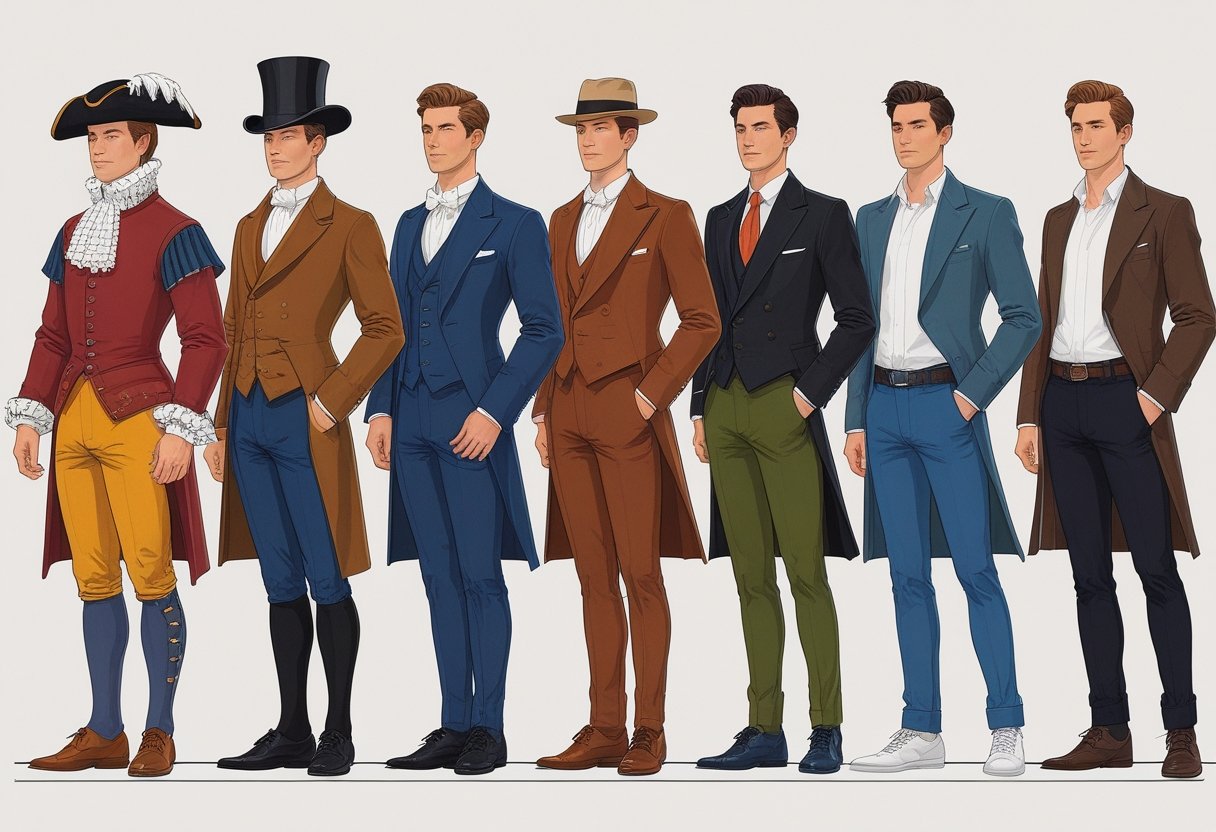
Every decade brought its own vibe, new fabrics, and fresh ideas that challenged what came before. Fashion isn’t just about looking good—it’s tangled up with how we work, play, and see ourselves.
Some pieces stick around forever. Others? They vanish before you know it.
Key Takeways
- Men’s fashion shifts as culture and society do.
- A few styles and items manage to stay influential for decades.
- Modern looks blend tradition with newer, more diverse trends.
Defining Men’s Fashion Trends
Trends in men’s fashion don’t come out of nowhere. They’re shaped by social changes, cultural shifts, and the influence of a few big names.
Understanding all this helps you see why certain looks take off—and why your closet might look the way it does.
The Role of Social and Cultural Influences
Social events and cultural movements leave big marks on men’s fashion. Think about the rise of casual wear after World War II—people just wanted to relax a bit more.
Streetwear’s explosion in recent years? That’s tied to urban culture and a new kind of youth identity.
Money matters too. When times are good, people lean into bolder, more expressive clothes.
During tougher periods, things get simpler and more practical.
Ideas about masculinity and gender are shifting fast, and fashion’s right there with it. Gender-fluid designs are popping up everywhere, breaking away from the old rules.
It’s all a reflection of what’s happening in society.
Impact of Fashion Icons and Designers
Designers and style icons have always set the tone.
Calvin Klein, for example, made minimalism cool in the late 20th century—those clean lines stuck around. Designers experiment with new fabrics, cuts, and ideas, always pushing boundaries.
Celebrities and athletes? They’re trendsetters too. When someone famous rocks a look, it’s only a matter of time before it’s everywhere.
Designers with a strong vision can either set off long-lasting trends or create short-lived crazes. Either way, they’re the ones steering the ship.
Milestones in Men’s Fashion Through the Decades
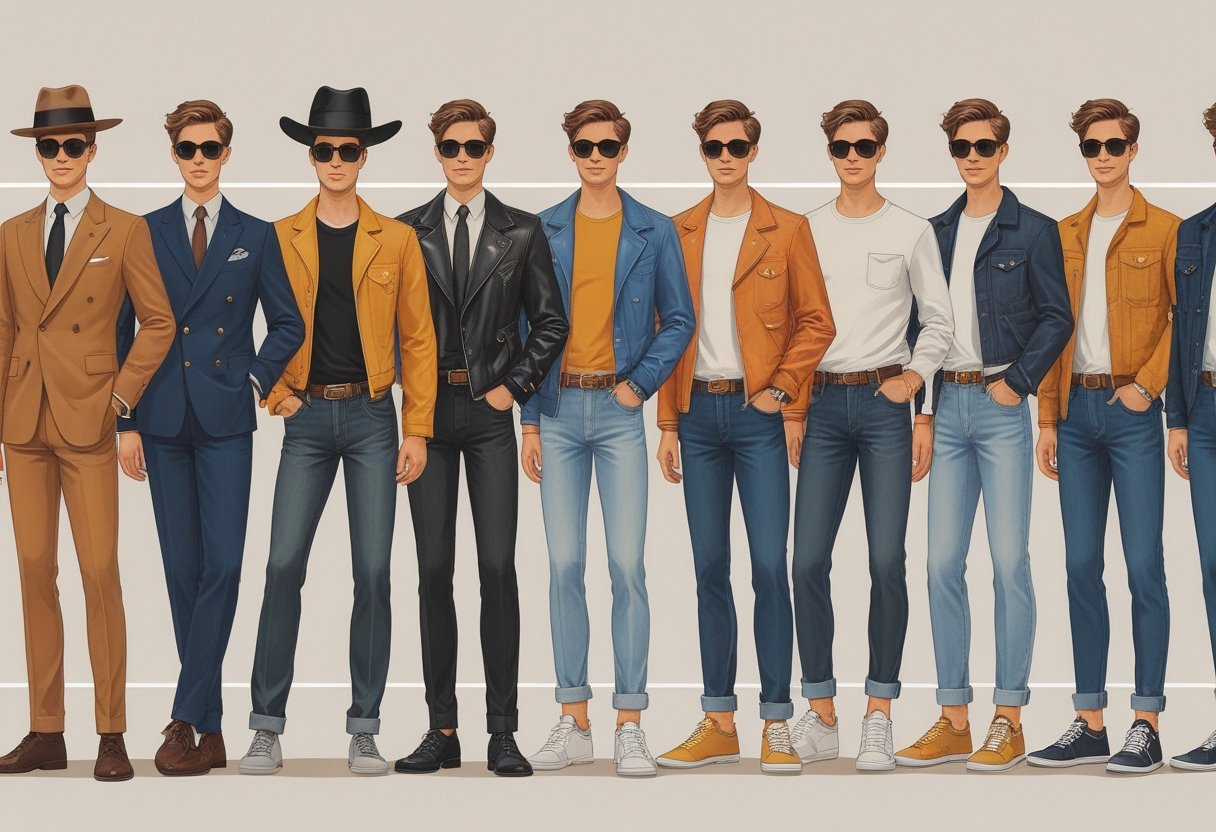
Men’s fashion has gone through some wild shifts—sometimes all about practicality, sometimes about making a statement.
There’s always this push and pull between formality, comfort, and individuality.
The 1920s–1930s: Birth of Modern Menswear
The 1920s brought in tailored suits with slimmer cuts, waistcoats, and those wide-legged trousers. Comfort started to matter, but sharpness was still the goal.
Three-piece suits ruled the Jazz Age, usually paired with slim lapels and shiny shoes.
By the 1930s, the silhouette got bolder. Double-breasted suits, broad shoulders, and tapered trousers were in.
Fedora hats and pocket squares finished the look. Even during the Great Depression, men kept it elegant—just a bit more practical.
The 1940s–1950s: Casual Wear and Military Influences
World War II changed everything. Military gear like bomber jackets and trench coats found their way into everyday wardrobes.
Fabric rationing meant suits got simpler—single-breasted, narrow lapels, less fuss.
After the war, casual wear took off. Khakis, leather jackets, and denim jeans became go-tos for younger guys.
The 1950s gave us icons like James Dean, who basically made the leather jacket and white tee combo legendary.
The 1960s–1970s: Counterculture and Bold Expression
The 60s and 70s broke all the old rules.
Early 60s Mod style was about slim suits, narrow ties, and Chelsea boots. Suddenly, bright colors and patterns replaced the old dull stuff.
Late 60s hippie style brought in loose, flowing clothes with fringe and wild prints. The 70s doubled down with bell-bottoms and silk shirts.
Denim and leather jackets screamed rebellion and freedom.
The 1980s–1990s: Power Dressing and Subcultural Style
Power dressing took over the 80s. Big shoulder pads, sharp suits, and bold accessories meant business.
Brands like Armani made the suit a status symbol. But subcultures were doing their own thing.
Punk brought in ripped denim and leather; hip-hop gave us baggy jeans and graphic tees.
By the 90s, fits got looser and more relaxed, thanks to grunge and street culture.
2000s to Present: Streetwear and Digital Age
Since 2000, streetwear’s been everywhere.
Casual comfort meets designer hype—sneakers and graphic tees are daily essentials. Skinny jeans had their moment, but now they’re sharing space with baggier fits.
Bomber jackets and layered looks show versatility.
Social media and fast fashion keep trends moving at lightning speed.
Men are experimenting more—skirts, pearls, you name it. Fashion now is this wild mix of retro, comfort, and bold personal choices.
Explore more on the evolution of men’s fashion through the decades.
Iconic Men’s Fashion Items
Some clothing items just have staying power. They’re the backbone of men’s style, balancing tradition and trend.
It’s all about sharp tailoring, standout outerwear, and pants that work in almost any situation.
Suits, Waistcoats, and Classic Tailoring
A good tailored suit is still the gold standard for formal wear. The details change—slimmer cuts are in right now—but the basics are timeless.
Waistcoats, especially as part of a three-piece suit, add a layer of polish. Structured shoulders and lapels come and go with the trends.
Wool for winter, lighter fabrics for summer. You can wear a suit almost anywhere, which is probably why they never really go out of style.
Statement Outerwear: Jackets and Coats
Bomber jackets, leather jackets, and fringe jackets—each one has its own moment.
Bomber jackets started out as military gear, but now they’re a casual staple. Leather jackets? Always cool.
Fringe jackets, big in the 60s and 70s, are for when you want to make a statement.
Different jackets, different moods, but all of them can take a basic look up a notch.
Essential Pants: From Chinos to Bell-Bottoms
Chinos and khakis—can’t go wrong. They’re comfortable, clean, and fit in almost anywhere.
Neutral colors make them easy to match. Bell-bottoms, on the other hand, are pure 70s drama.
That flared leg stands out, especially compared to today’s slim or straight styles. Pants might seem simple, but the right pair can totally change your look.
Influential Trends and Styles
Some trends shake things up, others simplify everything. Both have changed the way men dress and think about clothes.
It’s fascinating how style can reflect bigger shifts in work, comfort, and even identity.
Mod and Power Dressing Movements
The 60s Mod look was sharp—fitted suits, bold patterns, Chelsea boots.
It was about standing out, being young, and rebelling a little against the old guard. Clean lines, but with personality.
Power dressing in the 80s was all about authority. Wide ties, big shoulders.
The suits were more structured, meant to make you look ambitious and ready to take over the world. It wasn’t just about fashion—it was about making a statement at work.
The Rise of Minimalism and Casual Wear
Late 20th century? Minimalism started to take over.
Designers leaned into clean lines, neutral colors, and simple cuts. Suddenly, casual wear was everywhere—even in places where suits used to be the only option.
Denim jeans, bomber jackets, and plain tees became the new uniform. Comfort started to matter just as much as looking sharp.
The line between formal and casual got blurry, and honestly, that’s made dressing a lot more fun.
The Streetwear Revolution and Contemporary Fashion
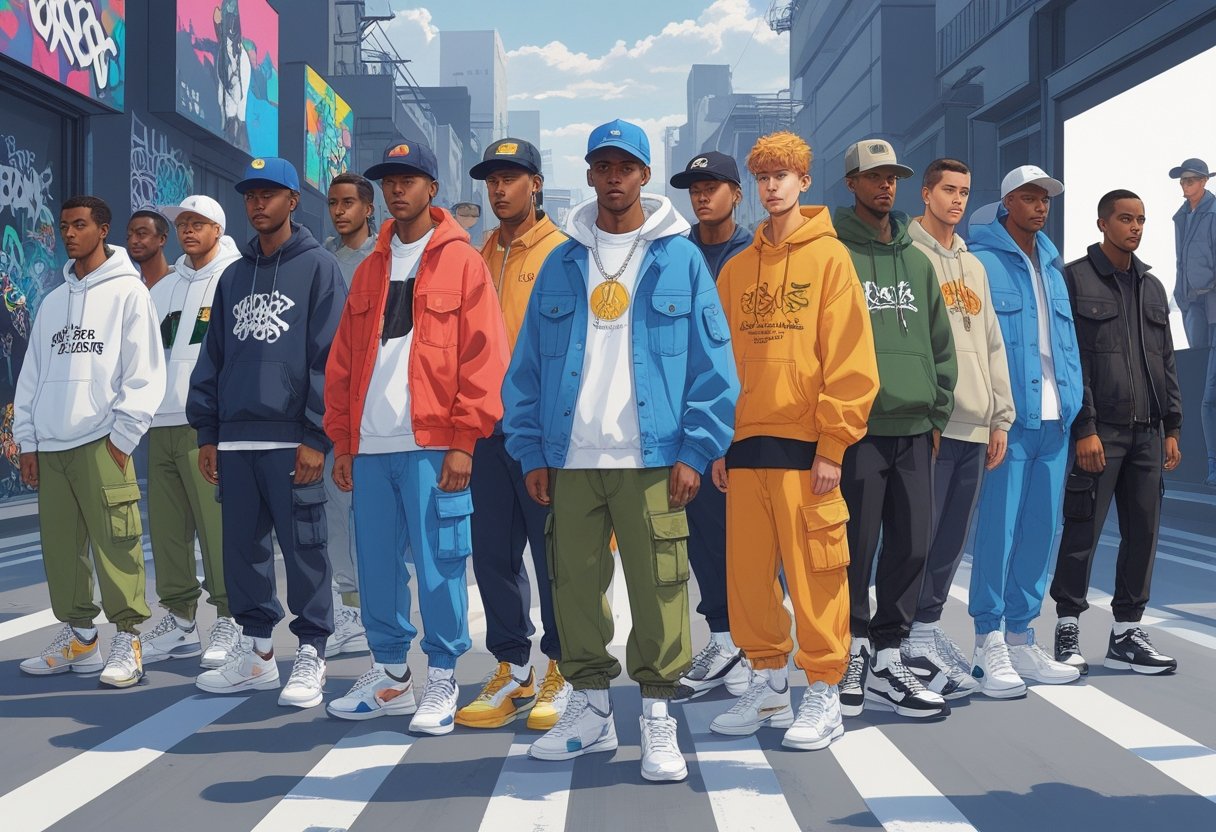
Streetwear turned men’s fashion on its head. Suddenly, comfort and bold urban style were everything.
Statement sneakers, graphic tees, and relaxed denim—these are the new essentials.
Emergence of Streetwear Culture
Streetwear started with skateboarding, hip-hop, and youth culture. It was about not caring what the old rules said.
Brands like Supreme and Off-White made limited-edition drops a thing. If you wanted it, you had to move fast.
Authenticity matters here. Streetwear is about telling your story through what you wear.
Baggy jeans, oversized hoodies, and sharp accessories all mix together. It’s a shift from formal to accessible, urban style.
Sneakers and Urban Essentials
Sneakers are more than just shoes now—they’re status symbols.
Limited releases from Nike and Adidas create serious hype. Collectors and fans track every drop.
Crossbody bags and caps add some utility, but they’re fashionable too. The right sneakers can make or break a streetwear look.
Graphic Tees and Everyday Style
Graphic tees are everywhere in streetwear—easy, expressive, and fun.
Wearers use them to show off their interests, favorite bands, or just some cool art. Sometimes it’s a logo, sometimes it’s a wild print.
Pair a graphic tee with denim—slim or baggy jeans, whatever fits your mood. It’s comfort with attitude.
There’s a reason these basics keep showing up in every city.
For more details on the streetwear influence, see The Evolution of Men’s Fashion in Urban Spaces.
Cultural Phenomena and Subcultural Statements
Men’s fashion is often about more than just the clothes.
Styles born from subcultures—punk, hip-hop, mod, grunge—have shaped the way generations express themselves. These looks are bold, sometimes a little weird, but always meaningful.
If you’ve made it this far, you’re probably as obsessed with style as I am. Want weekly inspiration, fresh news, and a deeper look at how dressing well can help you live better? Join my newsletter. Every week, I’ll send you three style ideas, the latest trends and events, plus a deep dive into the world of dressing and living better. Don’t miss out—subscribe and let’s level up together.
Disco and Glam: Platform Shoes and Vibrant Patterns
The 1970s disco era was a wild time for fashion. Bold patterns and loud choices took center stage.
Guys rocked platform shoes—seriously, those things added inches and a whole lot of attitude. Wide-legged pants and shiny fabrics like satin or polyester caught the light on packed dance floors.
Patterned shirts, the kind you’d spot in any decent club, were everywhere. Oversized sunglasses and flashy accessories just amped up the vibe.
This was all about showing off some personality, breaking away from the usual stiff dress codes. Who wants to blend in when you can stand out?
Counterculture Era: Tie-Dye and Fringe
Late ’60s and early ’70s counterculture? That’s when tie-dye shirts and fringe jackets really meant something.
Tie-dye was about nonconformity—bright, swirling colors, usually homemade. Fringe, especially on jackets and vests, nodded to a more natural, bohemian outlook.
These looks were a big part of the hippie movement. They let guys express peace, freedom, and a little rebellion.
It’s wild how these details—texture and pattern—still echo in today’s casual menswear.
The Enduring Impact of Iconic Brands
Some brands just change the game. Calvin Klein, for instance, made simplicity feel luxe.
Their clean lines and neutral colors basically rewrote the rules for men’s style in the ’90s. Underwear and denim weren’t just basics anymore; they were must-haves.
It’s proof that understated style can stick around and make a real statement.
Modern Perspectives and Sustainable Fashion
Men’s fashion now? It’s not just about looking good. There’s more focus on responsibility, creativity, and just making smarter choices.
Personal style gets to shine, but there’s this underlying current of “do better”—for yourself and the planet. That’s a shift worth paying attention to.
The Shift Toward Ethical Fashion
Ethical fashion is huge in 2025. It means thinking about how clothes are made—who makes them, what they’re made from.
Organic cotton, recycled materials, even algae-based leather are all in the mix. Some brands are getting creative with circular fashion, pushing people to recycle old clothes.
People are finally leaning towards quality over quantity. Slow fashion beats chasing every micro-trend, right?
It’s about finding pieces that last and actually matter, not just another T-shirt you’ll toss in a month.
Personalization and Individual Expression
Men are breaking out of the box, style-wise. They’re picking clothes that really say something about who they are.
Bold colors, wild prints, even gender-fluid pieces—there’s more room for experimentation now. Custom-made and artisanal pieces are getting more love, too.
It’s less about blending in, more about finding something with a story or a bit of soul. Mass-produced just doesn’t cut it for everyone anymore.
If you want to dive deeper into these shifts, check out Men’s Fashion Trends 2025: A Combination of Innovation and Tradition.
Oh, and if you’re into this kind of thing—style inspiration, the latest drops, events, and real talk about dressing and living better—why not join my newsletter? I send out three pieces of inspiration each week, along with news and a deep dive into the world of men’s style. It’s a little boost for your wardrobe and your mindset. Sign up and let’s level up together.
Frequently Asked Questions
Men’s fashion has morphed a lot since the 1800s. New styles, fabrics, and cultural shifts have shaped how guys dress, decade after decade.
Big events, social changes, and tech breakthroughs? All played their part.
How has men’s fashion changed from the 1800s to the 20th century?
Back in the 1800s, it was all about formality—heavy layers, dark colors, and strict tailoring. By the 20th century, things got simpler and more practical.
Tailored suits replaced those fussy coats. The dinner jacket and lounge suit showed up, making life (and style) a bit comfier.
What are some of the key milestones in the history of men’s fashion?
Late 1800s: tuxedo and sack suit arrive. The roaring ‘20s brought lighter fabrics and sporty looks.
During the 1940s, utility suits were a thing—wartime rationing and all that. The ‘60s and ‘70s? Think bold patterns and colors. By the ‘90s, minimalism and streetwear took hold, thanks to youth culture.
Can you describe the major shifts in men’s fashion during the 1900s?
Early 1900s was sharp tailoring—three-piece suits everywhere. World War I brought in military styles like trench coats and muted colors.
The 1920s loosened things up—brighter hues, new fabrics. Wartime in the ‘40s meant practical clothes. Later decades just kept shaking things up, moving away from the old rules.
What factors have influenced the evolution of men’s fashion trends?
Culture, war, economics, tech—you name it. Wars simplified designs and made people think about fabric use.
Economic booms brought in more luxury. Youth culture pushed for casual looks. Even cars changed how people dressed and accessorized.
How does historical context shape the trends in men’s fashion?
Wars, financial crises, and big social changes all left their mark. Sometimes fashion swung toward function, other times toward luxury.
Political and cultural movements sparked experimentation. Fashion always reflects what’s happening in the world, for better or worse.
What are some notable sources to learn about the history of men’s fashion?
If you want to really dig into the history of men’s fashion, you’ll find some goldmines out there. There’s a decade-by-decade review on “The Evolution of Men’s Fashion: A Decade-by-Decade Breakdown” over at beststuffforguys.com.
Another solid read is “History of Men’s Fashion: 100 Years of Innovations & Trends” on fashionbeans.com. Both break down timelines, highlight those pivotal moments, and get into the cultural shifts that shaped how men dress.
Honestly, if you’re into this stuff, you should join my newsletter. Every week, you’ll get three style inspirations, the latest news, events, and trends, plus a deep dive into dressing, being, and living better. Don’t miss out—sign up and let’s level up together.
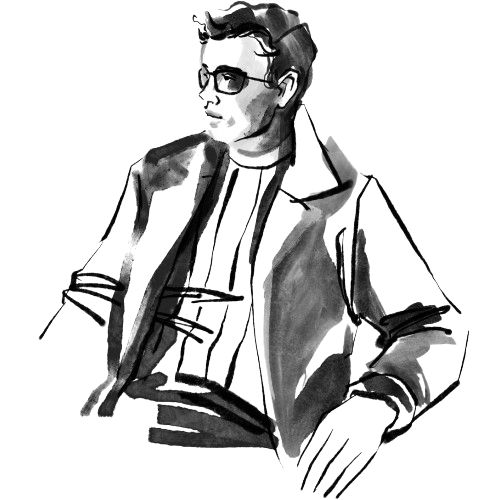
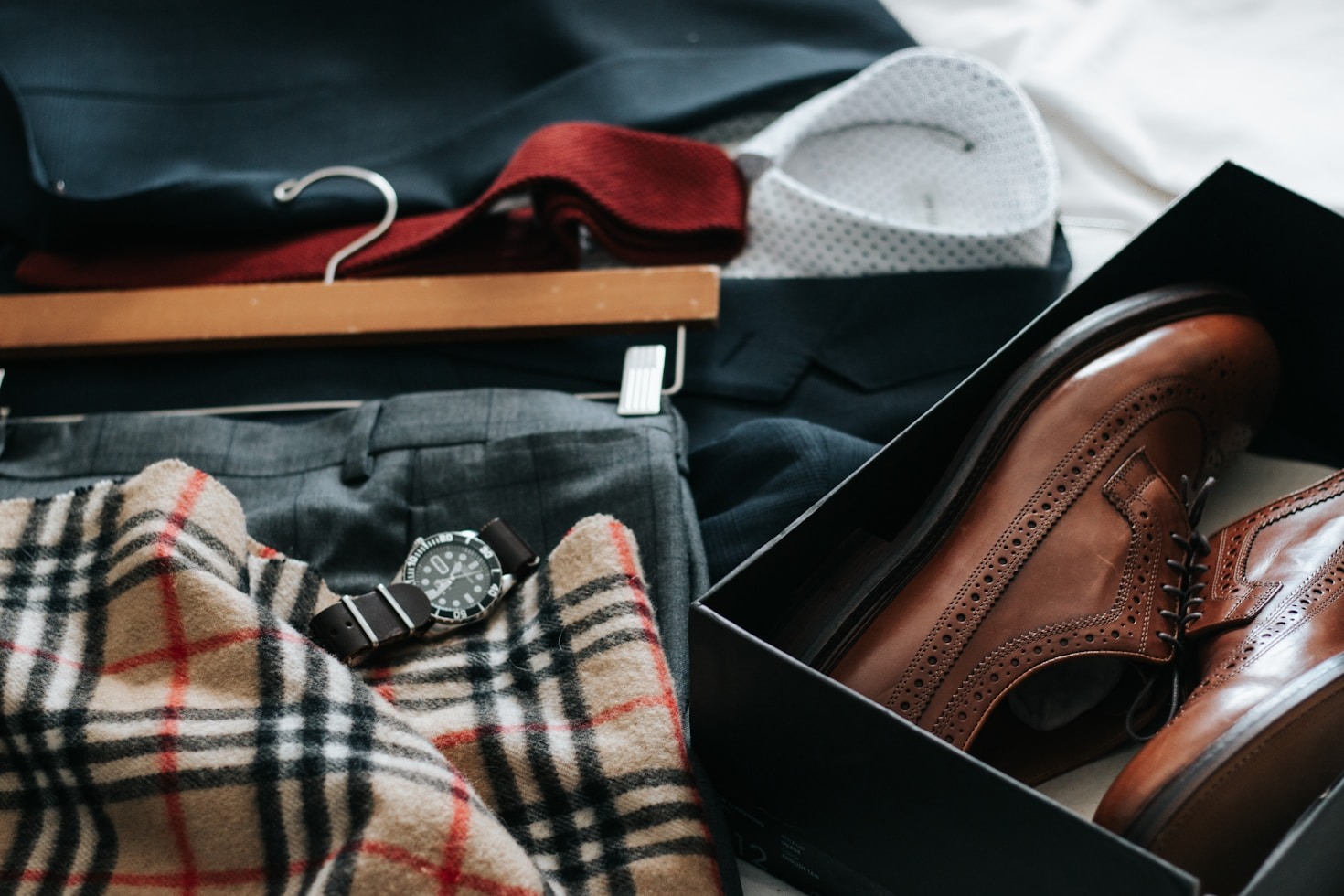
Leave a Reply